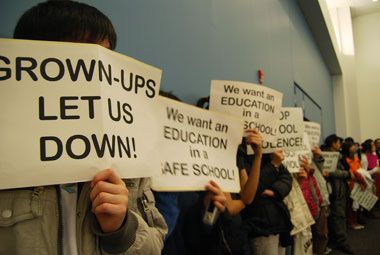Culture, Not Curriculum, May Be Key to High School Reform

Resurrecting a struggling high school is more about changing culture than curriculum, according to Charles Payne, a University of Chicago professor and affiliate of the university’s Urban Education Institute.
Schools should be places where teachers are trusted, students are challenged, and parents are engaged, Payne said Friday at an annual conference hosted by the Education Trust, an advocacy group. When that happens, students show up and teachers stick around, and that alone can boost student achievement.
“If you can get your students to … show up regularly, if you can get the teachers to stay in one school … then students have a better chance to develop, even if we hold the quality of teaching constant,” he told a ballroom full of educators and administrators. “We’ve got to stop worrying about the particular plants we are planting, and worry more about the soil.”
[Find out what teachers wish parents asked at conferences.]
Teacher collaboration, strong community ties, rigorous instruction, supportive leadership, and a safe learning climate can all help change the makeup of the soil, he said, but those elements are futile on their own. Without support from their principal, colleagues, and parents, educators who are excited about engaging their students will eventually revert back to the status quo of teaching with workbooks and answer sheets, he added.
“[They] get tired of being the hardest working person on a staff where the other teachers are almost laughing at [them],” Payne said. “You can create all the pockets of good instruction you want, [but] if the organizational environment doesn’t support [the change], it is likely to destroy it.”
[Read how high school teachers put training to work.]
School districts that have transformed their culture, often through a change of leadership, have seen improvements in graduation rates, drops in truancy levels, and increases in college readiness, he said, pointing to Baltimore City Public Schools, Montgomery County Public Schools in Maryland, and New York City Public Schools as examples.
In New York, district administrators revitalized a push toward smaller schools focused on personalized attention and community partnerships. As a result, graduation rates for minority students improved 8 percentage points, Payne noted.
Administrators in Baltimore started throwing annual block parties to connect with students, and cut down on the number of long-term suspensions. Graduation rates at Baltimore high schools are up 20 percent from four years ago, and up 26 percent among black male students, he said.
Montgomery County schools shrunk the achievement gap at all grade levels, in part because district officials moved their top talent to underserved schools, Payne added.
“There are some groups of African-American and Hispanic students who, when they get a different caliber of teachers, can turn on a dime,” he added. “Montgomery County cannot be the only place where those students exist.”






